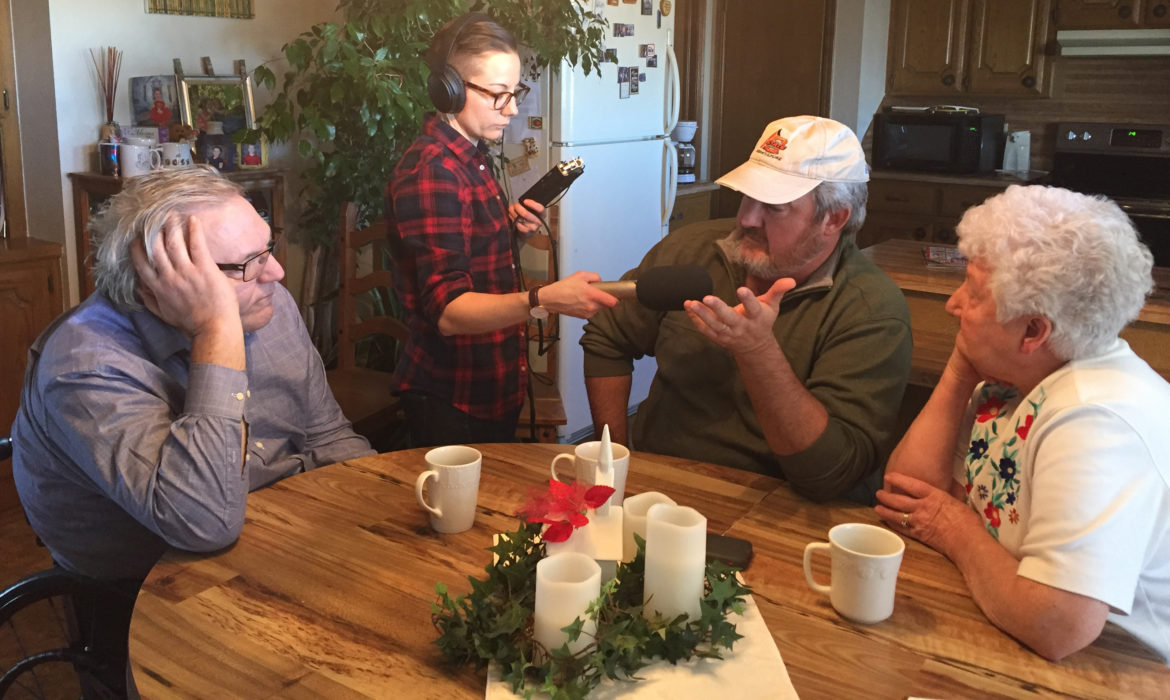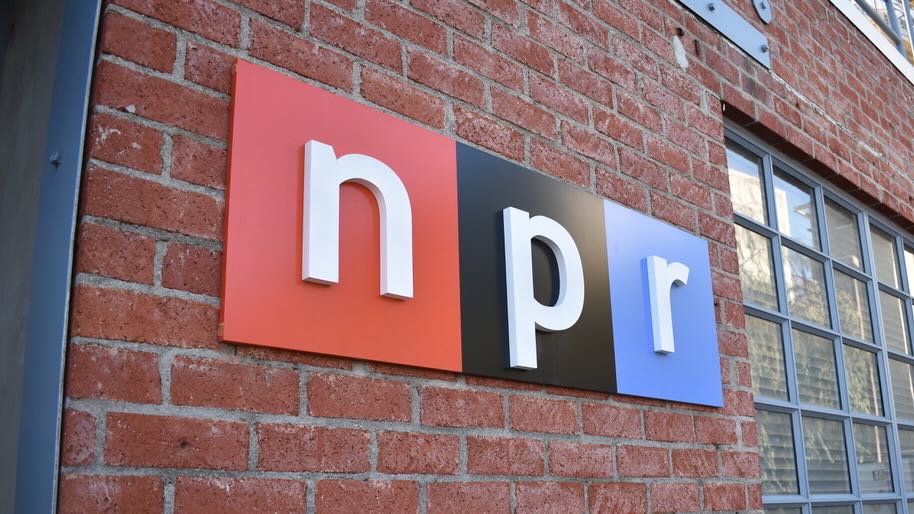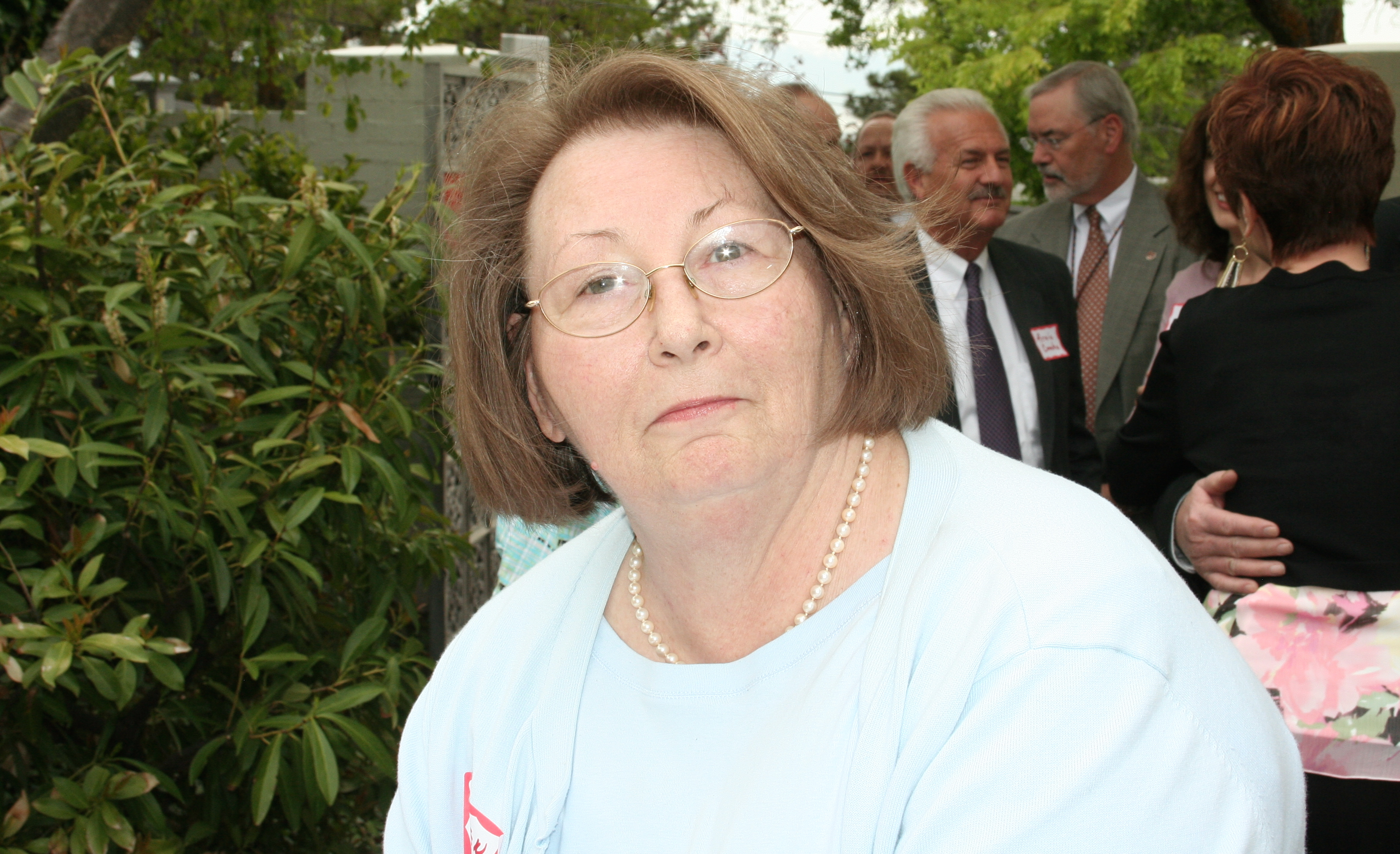Connecting with people who think public radio isn’t for them

Rachel Hubbard/KOSU
John Hockenberry and Amber Hall of “The Takeaway” talk with Clay and Jacquelyn Pope at their home in Loyal, Okla.
As the daughter of immigrant parents living in central Jersey, I never had a “driveway moment” while growing up. Members of my family were loyal radio listeners, but we mostly tuned to stations for weather and traffic updates or ’90s pop songs.
I had never heard of public radio or NPR and, in the countless times I must have passed 93.9 FM on the radio dial, I assumed those voices weren’t talking to me.
We were a middle-income family living in an upper-to-middle-income town, home to only a small handful of Muslim families like my own. We were avid news readers and consumers, and highly engaged in civics and politics, but public radio never felt like a space welcoming us in. I think back now and wonder why. Was it too boring for the number of kids we always had in the car? Did the segments dedicated to easy recipes (for cuisine we didn’t cook) or holiday songs (for holidays we didn’t celebrate) feel too foreign, as if they were not designed for us, an immigrant family?
Then, during the summer before my senior year at New York University, I landed an internship at NPR, and soon discovered the ethos of public radio and the power of great storytelling. It was a mission that I came to believe in deeply because it spoke to why I wanted to become a journalist in the first place. I became enamored with the breadth of public radio’s reach, the huge influence of its coverage and the loyalty of its listeners. From there, I was hooked, and I’ve stayed in public radio ever since.
More than a decade later, I now run The Takeaway, the PRI/WNYC newsmagazine hosted by John Hockenberry. Each weekday program is heard by millions of listeners throughout the country. Like any other show, we measure our success in part on metrics: the number of listeners, how long they listen, when they listen, etc. To me it’s just as important to ask: Who’s not listening? I think back to my childhood and why my family didn’t gravitate towards public radio. I’ve never forgotten the disconnect I felt for so many years, and I wake up most mornings thinking critically about what can be done to bridge that gap.
As the executive producer of a news program, I want to hold my show up to the standards that I believe define public radio: to be a voice of the community, to provide a microphone for everyone, especially the marginalized — whether they live in urban liberal America or rural conservative America. I want The Takeaway to tell stories otherwise forgotten, that pull at the threads that supposedly define our social fabric and question the very values that we claim define us. I want to take the lessons of news media’s shortcomings in covering the 2016 election, which were myriad, and reset the boundaries of how we talk about everything from politics to income inequality, social justice and race. And, perhaps most importantly, I want to better listen to the people who make up the “public” part of our mission and hear their concerns, struggles and stories.
So how do we do this?
To bridge this divide and bring more voices to the table, The Takeaway has embarked on a series of road trips, traveling to cities and towns across the country where Trump won handily. Our goal is to speak with as many Trump supporters as we can; we want to better understand their economic and social conditions, the changes they are hoping to see and how they’ll measure President Donald Trump’s success.
Immediately following Trump’s inauguration, John Hockenberry got on a plane to Oklahoma City, where we produced shows out of KOSU during the week of Jan. 23.

(Photo: Amber Hall)
Station GM Rachel Hubbard guided our team’s editorial direction by giving us a primer on Oklahoma politics and economics, finding families who invited us into their homes and directing us to Cushing, the epicenter of the oil industry that is increasingly prone to earthquakes as a result of fracking. We learned of the dire condition of the state’s budget and its woeful impact on some school districts that have now moved to four-day school weeks. We learned that many Oklahomans make their livelihood not just from one industry, but from many industries, oftentimes balancing jobs in agriculture, wind farming, and the oil and gas business to support their families.
After the broadcasts several listeners from rural Oklahoma told us how much they appreciated hearing their stories covered in a national show. Many Trump supporters let us know how the economic realities of their lives influenced their votes in November. In the upcoming months, The Takeaway will travel to other communities that voted for Trump, including towns in upstate New York and eastern Oregon.
We are also launching a new project that examines race relations in America. Partly inspired by the “Dear President” project taking place at my home station, WNYC in New York, The Takeaway is challenging both listeners and people within the public radio network to have difficult conversations about race and identity.
Anna Sale, host of the podcast Death, Sex & Money, sat down with her high school prom date, a Muslim-American whose lifestyle and values she says she never understood in her white, rural, West Virginia town. Anne Hillman from Alaska Public Media gathered folks in the Anchorage community to hear how both natives and non-natives are engaging in discussions about identity. Jasmine Garsd, a reporter with PRI, is reflecting on being a white Latina raised by a brown mother and often passing as a white American rather than an Argentinian immigrant.
We’re calling on any and all reporters and hosts within the public radio family to participate and help us create models/examples for how others can think about structuring their own conversations about race and identity. Then we’ll ask our listeners to do the same and take on this challenge.
These projects are just a part of our greater call for renewal, the theme of a recent essay John Hockenberry wrote for The Takeaway’s first broadcast of 2017.
“I want to reach out to the entire community of curious, interested people and renew the idea of public radio, public media,” Hockenberry said. “Let 2017 be the year we make something more public, more new, less categorizable, more young, more of everyone in this country.”

Gunja
As we enter a moment in history where America seems more divided than ever before, The Takeaway wants public radio be a place for all people, a place where no matter where you come from or what views you espouse, your story is part of the public radio story. The measure of our success — and the success of this industry — will be whether families like mine are not only listening, but hearing their stories on our airwaves.
Arwa Gunja returned to The Takeaway, a national radio program from New York’s WNYC and PRI, as executive producer last fall. She had left her previous job as senior producer of the show in 2015 to become EP of Freakonomics Radio, another WNYC production. Arwa got her start as a producer at NPR, where she worked on several programs, including Morning Edition and Tell Me More, and produced coverage of the 2008 presidential election.








Not that I disagree with anything this article says, but I would think a major reason why public radio isn’t being listened to by large subsets of the population is because, by and large, public radio really sucks at marketing itself.
The old saw of “a dollar spent on marketing a crappy product has far greater ROI than a dollar spent on making the product better” is one that public radio has rightly decided to turn on its head…but I’d argue they’ve gone way too far. You can have the best product in the world and it won’t matter one bit if you don’t market it, and aggressively, to your likely customers.
Pubradio generally thinks there’s only three kinds of marketing: live events, social media, and their own AM/FM signal. All three of which inherently only market to their existing customer base…unless you make SUBSTANTIAL efforts to push beyond them.
Where’s the advertising in newspapers? On billboards? On TV? Where’s the social media ad buys targeted on users who aren’t listeners, but are likely to be converted? Where’s the ad campaign tailored specifically for non-listeners and specifically to dispel common myths and replace them with more attractive mental schemas? Where’s the contests designed to get people listening and keep them listening?
This is why you often see an overall rise in public radio listenership when there’s two big pubradio outlets in town and they’re going at it head-to-head. It’s not the competition, it’s that both stations suddenly realize the need to market themselves better.
I’m all for NPR (and PRI, etc) doing more in their programming to reach out to these underserved audiences, but unless you have a big marketing campaign to go with it…you’re likely just going to annoy your established listener base without drawing in anyone new.
In Chicago, WBEZ did a sizeable billboard campaign built on the idea of calling upon smart people to have more babies (contradicting the whole premise of the film “Idiocracy”) for what the ads called the “WBEZ 2045 membership pledge drive.” Probably too cute for its own good and hard to explain, especially on billboards, but it got some notice.
Yeah, there’s been a few billboard campaigns out there. Some pretty good, some exceedingly clever, some too clever for their own good. But rarely do you see it outside of the “big boys” in major markets: WBEZ in Chicago, as you said. WBUR & WGBH in Boston. KPCC in LA. Etc etc etc.
The Takeaway is also aired on ‘GBH, which is a contributor station of this programme. Weekdays at 10 am and 2 pm EST. https://uploads.disquscdn.com/images/07e5026d484de05647fc01f3c20ec92b5f7d6597c5b1490d160dd559a18b81fb.jpg 89.7 WGBH, Boston’s Local NPR.™ Online stream: http://www.wgbh.org – WGBH app – NPR news app.
Please be sure to ask them how they feel about families like yours…